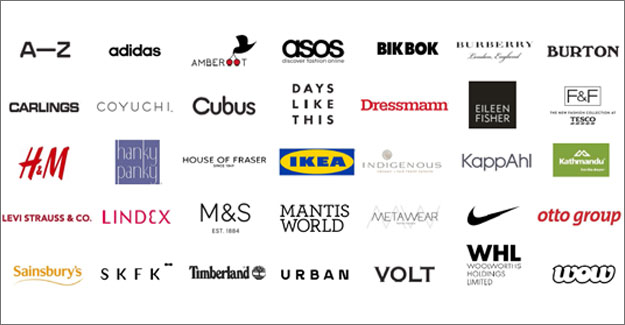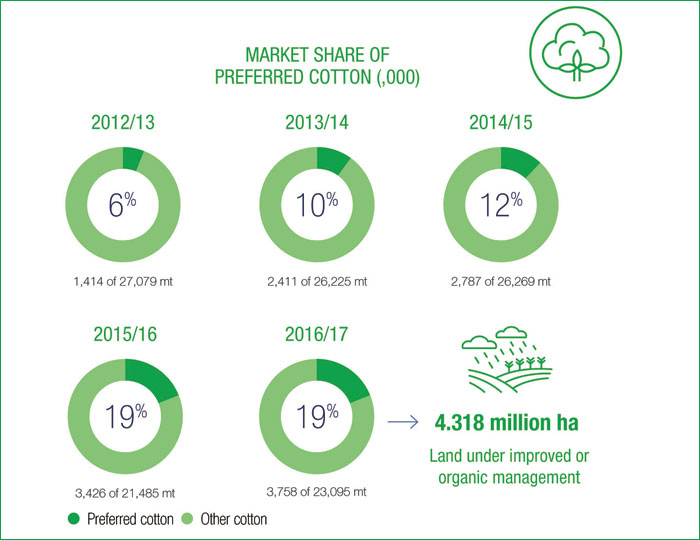
Brands Steadily Increase Sustainable Cotton Usage
Textile Exchange recently released the 2025 Sustainable Cotton Challenge Report, 2018, showcasing the progress made over the last three years, in increasing the use of sustainable cotton. Over the three years, 111 leading brands from 17 countries have signed up to the challenge of using 100% sustainable cotton by 2025. Progress so far For the 2018 report, 30 of the 39 signatories of the 2025 Sustainable Cotton participated in the Preferred Fiber and Materials (PFM) Benchmark Program. Aim: 100% sustainable cotton by 2025 Current status: Of the 30 cotton 2025 signatories that have completed the PFM benchmark program:
- 10% of cotton 2025 signatories have achieved their pcotton 2025 target of 100% preferred cotton usage, all of which are organic
- 37% have achieved a pcotton share of between 75-99%
- 23% have achieved pcotton share of between 50-74%
- 7% have achieved a pcotton share of between 25-49%
 It is estimated that the market share of preferred cotton will increase to 24% in 2017/18. The preferred cotton figures include cotton certified to the BCI Standard, ABRACA, myBMP, Cotton made in Africa, REEL, Cleaner Cotton, e3, organic and Fairtrade cotton. The BCI standard without equivalents made up around 47% of all preferred cotton in 2016/17.
All BCI cotton including its equivalents ABRAPA, Cotton made in Africa and myBMP made up around 87% of all preferred cotton. The Brazilian standard ABRAPA, is with a market share of 32% of all preferred cotton, by far the most used standard apart from the BCI standard and the most widespread BCI equivalent.
Future of Cotton From 2025-2040
The 2025 Sustainable Cotton Challenge and the Cotton 2040 project share common leadership and a common vision.
Cotton 2040, like the 2025 Sustainable Cotton Challenge, is also a multi-stakeholder initiative to significantly increase the use of sustainable cotton internationally. Facilitated by Forum for the Future, it brings together leading international brands and retailers, including M&S and Target, sustainable cotton standards, existing industry initiatives and other stakeholders across the value chain. Cotton 2040 is co-funded by C&A Foundation.
Today
19% of the world's cotton is more sustainable.
2025
Over 50% cotton volume has been converted to more sustainable solutions. The rest of the industry understands the issues and solutions and is following the lead.
2030
The United Nations Sustainable Development Goals Textile Sector Report communicates significant impacts around water use and quality, biodiversity, food security and case studies supporting the journey to regenerative agriculture and resilient communities.
*2025 Sustainable Cotton Challenge and SDG Reports are hosted by Textile Exchange, and Cotton 2040 is hosted by Forum for the Future:forumforthefuture.org/cotton-2040
2040
The cotton industry has changed dramatically: it prioritizes sustainable practices, is highly transparent and traceable and provides viable livelihoods for farming communities.
How the challenge came into being
By 2016/17, production of sustainable cotton had reached more than 3.4 million mt, or 19% of total cotton produced. However, companies were actively buying less than one-fifth of this sustainable cotton. The other four-fifths were being sold into the general market, with no added financial benefit for those farmers who had made the switch, or any consumer-facing benefit for companies using such cotton in their products. This seemed to be an important and timely opportunity to encourage cotton purchasing companies to correct this disparity by transferring their cotton purchasing patterns to existing sustainable supplies and by building demand for further supplies that might help transform all cotton production to a more sustainable and resilient model.
In May 2017, at a high level meeting in London, the Sustainable Cotton Communique was launched. Thirteen of the world's renowned clothing and textile companies signed up to the 2025 Sustainable Cotton Challenge, a hugely encouraging step that would hopefully spur wider action across the sector and go a long way in helping to reduce the negative environmental and social impacts that are all too often associated with cotton production.
The commitment made by these companies equated to more than 300,000 metric tonnes (mt) of cotton purchased each year.
The aims of the Communique included steps to increase the uptake of organic and sustainable cotton which will in turn increase the income of smallholder farmers, eliminate highly hazardous pesticides, eliminate or reduce the amount of pesticides and synthetic fertilizer used, reduce water use and improve water quality and soil health, including positive carbon impacts as a result of more sustainable practices.
On October 11, 2017, a second announcement was made in Washington, D.C. at Textile Exchange's annual Sustainability Conference - an additional 23 of the world's renowned clothing and textile companies including Burberry, Adidas, Kathmandu and Timberland had signed the Sustainable Cotton pledge and would be using 100% sustainable cotton by 2025, bringing the total number of signatories up to 39. These signatories represent over one million mt of cotton usage, approximately 4% of global cotton production. In March 2018, Textile Exchange assumed the role of the initiative's Secretariat.
It is estimated that the market share of preferred cotton will increase to 24% in 2017/18. The preferred cotton figures include cotton certified to the BCI Standard, ABRACA, myBMP, Cotton made in Africa, REEL, Cleaner Cotton, e3, organic and Fairtrade cotton. The BCI standard without equivalents made up around 47% of all preferred cotton in 2016/17.
All BCI cotton including its equivalents ABRAPA, Cotton made in Africa and myBMP made up around 87% of all preferred cotton. The Brazilian standard ABRAPA, is with a market share of 32% of all preferred cotton, by far the most used standard apart from the BCI standard and the most widespread BCI equivalent.
Future of Cotton From 2025-2040
The 2025 Sustainable Cotton Challenge and the Cotton 2040 project share common leadership and a common vision.
Cotton 2040, like the 2025 Sustainable Cotton Challenge, is also a multi-stakeholder initiative to significantly increase the use of sustainable cotton internationally. Facilitated by Forum for the Future, it brings together leading international brands and retailers, including M&S and Target, sustainable cotton standards, existing industry initiatives and other stakeholders across the value chain. Cotton 2040 is co-funded by C&A Foundation.
Today
19% of the world's cotton is more sustainable.
2025
Over 50% cotton volume has been converted to more sustainable solutions. The rest of the industry understands the issues and solutions and is following the lead.
2030
The United Nations Sustainable Development Goals Textile Sector Report communicates significant impacts around water use and quality, biodiversity, food security and case studies supporting the journey to regenerative agriculture and resilient communities.
*2025 Sustainable Cotton Challenge and SDG Reports are hosted by Textile Exchange, and Cotton 2040 is hosted by Forum for the Future:forumforthefuture.org/cotton-2040
2040
The cotton industry has changed dramatically: it prioritizes sustainable practices, is highly transparent and traceable and provides viable livelihoods for farming communities.
How the challenge came into being
By 2016/17, production of sustainable cotton had reached more than 3.4 million mt, or 19% of total cotton produced. However, companies were actively buying less than one-fifth of this sustainable cotton. The other four-fifths were being sold into the general market, with no added financial benefit for those farmers who had made the switch, or any consumer-facing benefit for companies using such cotton in their products. This seemed to be an important and timely opportunity to encourage cotton purchasing companies to correct this disparity by transferring their cotton purchasing patterns to existing sustainable supplies and by building demand for further supplies that might help transform all cotton production to a more sustainable and resilient model.
In May 2017, at a high level meeting in London, the Sustainable Cotton Communique was launched. Thirteen of the world's renowned clothing and textile companies signed up to the 2025 Sustainable Cotton Challenge, a hugely encouraging step that would hopefully spur wider action across the sector and go a long way in helping to reduce the negative environmental and social impacts that are all too often associated with cotton production.
The commitment made by these companies equated to more than 300,000 metric tonnes (mt) of cotton purchased each year.
The aims of the Communique included steps to increase the uptake of organic and sustainable cotton which will in turn increase the income of smallholder farmers, eliminate highly hazardous pesticides, eliminate or reduce the amount of pesticides and synthetic fertilizer used, reduce water use and improve water quality and soil health, including positive carbon impacts as a result of more sustainable practices.
On October 11, 2017, a second announcement was made in Washington, D.C. at Textile Exchange's annual Sustainability Conference - an additional 23 of the world's renowned clothing and textile companies including Burberry, Adidas, Kathmandu and Timberland had signed the Sustainable Cotton pledge and would be using 100% sustainable cotton by 2025, bringing the total number of signatories up to 39. These signatories represent over one million mt of cotton usage, approximately 4% of global cotton production. In March 2018, Textile Exchange assumed the role of the initiative's Secretariat.

Textile Excellence
If you wish to Subscribe to Textile Excellence Print Edition, kindly fill in the below form and we shall get back to you with details.








